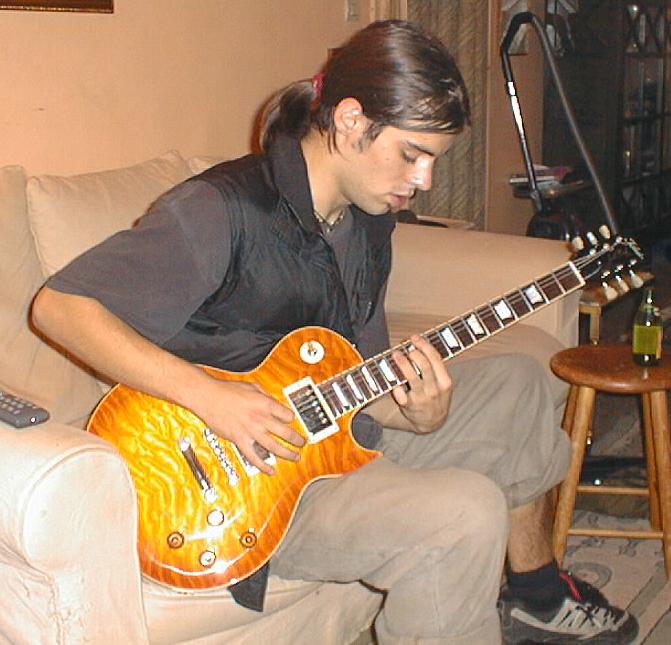
 The Dr Pickup video/
Concert files/
People /
Musical instruments /
The Dr Pickup video/
Concert files/
People /
Musical instruments /
Up coming Concert dates/
Home



A Stringkiller Guitar review -
The Ultimate Les Paul


Contents. September 2002. Why the ultimate
Les Paul?
·
Have a look.
·
A little background on the Gibson Les Paul.
One of the most successful
guitar designs of the twentieth century,
which is in top 5 most desirable guitarists for most pickers.
·
No longer second hand or used but 'Vintage' guitars
·
Then Tokai came along
·
An idea is sown
·
The deed is done
·
Stringkiller's Tokai at home otherwise known as the morning after
·
My initial impressions of the Tokai through some tube guitar
amplifiers
·
Where the catch? So everything is just wonderful about this guitar?
·
Specifications
Mai 2009. Stringkiller update.
I added and have now been using Bareknuckle's The Peter Green Blues humbucker set since last summer and now this guitar is really the Ultimate Les Paul. Better than ever.
Also I find that setting both the volumes and tone to 7 on the mid pickup position gives you four different sounds as you increase or decrease any of the four pots
- check it out.
Played through The Koch Studiotone (all the sounds I need at very low volumes) and the Koch Twintone this guitar sounds lovely.
Also this guitar sounds great through The Vox Custom Classics The AC15 Custom Classic with all the controls at 12
(Ok maybe 2 o'clock for the Top boost volume) and for louder gigs the AC30 Custom Classic.
A note on these amps My 15 I got with the Alinico Blue but the 30 I got the top and in the speaker cabinet one of the GSH12-30 speakers had blown
(hence the nice rite price) I added in a Celestion Vintage 30 and this amp really wails now.
Billy Gibbons Tokai picture added as requested.
October 2002. Stringkiller update.
I have removed all pricing details concerning the instruments listed in this web site.
Thank you to Graham, Webmaster gary-moore.com for correcting some information.
July 2006. Stringkiller update
Changing Bridge pickup with Tokai UK
Tokai Europe
See Pickups paragraph below.
New amplifier information added!
Now using
Kotch Twintone on stage and Dr Z Mini Z at home, recording and in rehearsals with either my Fender 65 Champ or Mesa Subway Boogie
Be sure to check out the fantastic Buddy Whittington on the Dr Z site under the mini Z and also on Youtube.com where one of the clips has him with a Les Paul.

Have a
look. This is my son, Alec, digging' on the Ultimate Les Paul guitar.

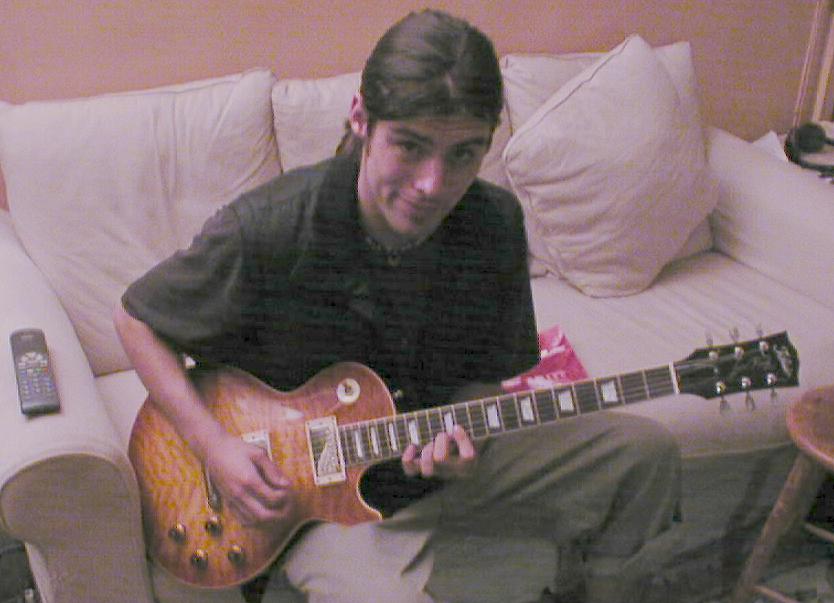

A little background
on The Gibson Les Paul -
![]()
one of the best guitar designs of the twentieth century.

Since PRS have been charging thousands of dollars /euros / pounds more for
outrageously beautiful woods on their very fine guitars....
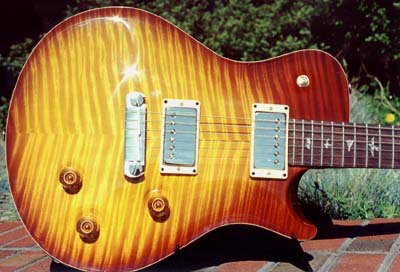
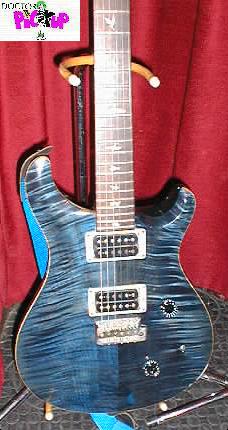
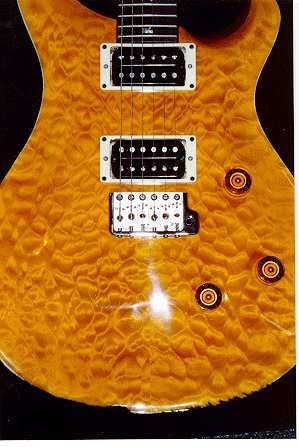

Fender have
listened and learnt from Keith Richards and other guitarists that some people
will actually pay more for pre aged and proper authentic replicas of their
immortal Stratocasters and Telecasters.

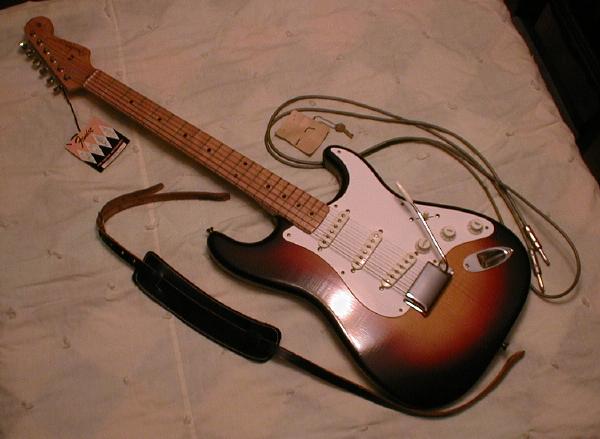

Gibson now ask some serious money for a beautiful pre aged Custom Shop 57 Gold
top reissue and you get the best of both worlds, beautiful woods and what
Gibson call Pre aged and Fender call Relics or Closet Classics or New old stock
(NOS).
Here are Gov't Mule's Warren Haynes Les Paul Standards from the Gibson Custom shop.
This guy has tone, technique and such a wide repertoire and a lot of his sound is due to these Gibson Les Paul Standards

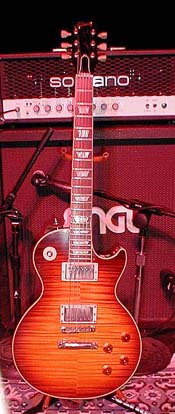
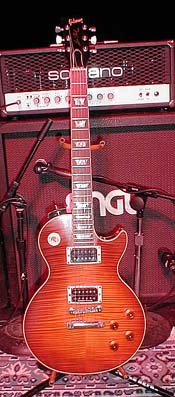
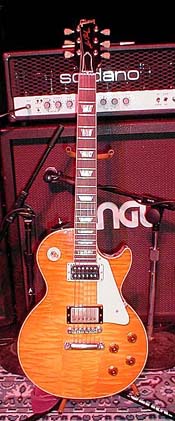

The picture below comes from E bay, and looks like a fantastic Gibson Les Paul
Classic
and is about the closest I have seen to mine.

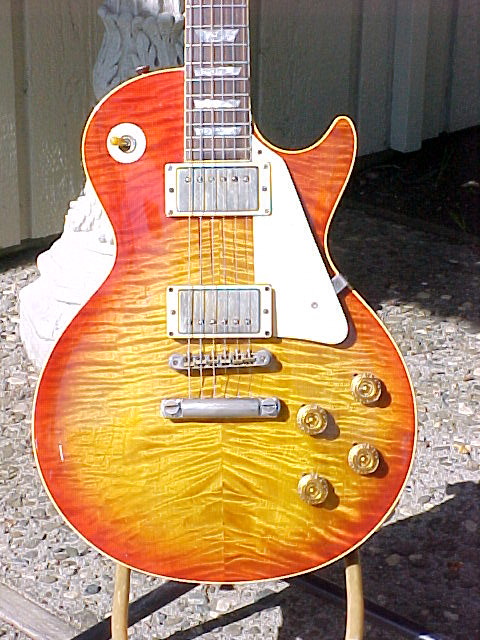

The Gibson Les Paul
Standard is one of the classiest guitars to hit the planet.
In 1952 Gibson Guitars released the Les Paul signature with a Gold top finish,
22 fret neck, crown fret board markers, trapeze bridge, two P90 pickups and the
words 'Les Paul model' on the headstock.

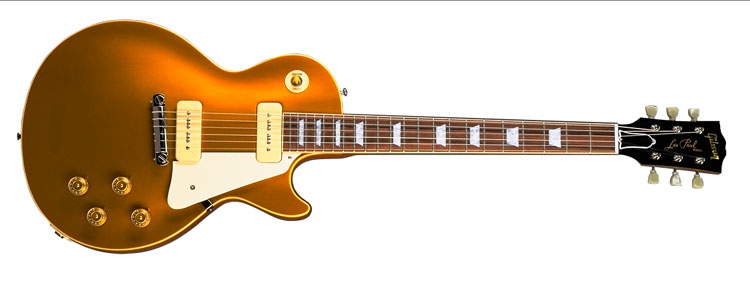

Notice the wrap around bridge and the P90 cream coloured pickups
Picture from the Gibson web site

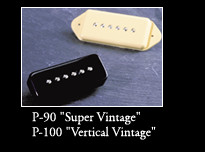

By 1954 the trapeze bridge unit had been replaced by a wrap around tailpiece,
most of these early Les Pauls I have played had intonation problems but the
ones that did not sound unique and great. Also a lot of these early models have
modified bridges and finishes which means they can be falsely presented as
later models.

Picture from the Gibson web site

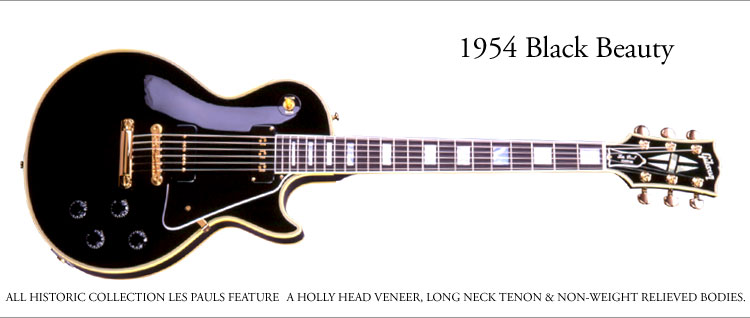

In 1954 Gibson
launched the Gibson Les Paul Custom, but that's a different model and not dealt
with here. But it heralded the introduction of the new Tune-o-matic bridge, which
is still the standard bridge on all Gibson electrics.
In 1956 Gibson introduced
the ABR1 bridge and tailpiece on both the P90 Les Paul and a new Gold Top
sprouting twin PAF humbucking pickups. In 1958 they bought out a cherry sunburst
finish and the 'burst' was born.
About 1,200 Gibson Les Paul Standards were produced in this cherry sunburst
finish from 58 to 60. The Les Paul Standard model was dropped from the 1961
Gibson catalogue. It was reinstated in 1968.
30 years later and until today I imagine that this is still the Gibson Flagship
guitar. Did the people, like Ted Mc Carthy, the President and Seth Lover, the
pickup designer at Gibson ever imagine that the late 1950s models would become so
sought after because of their feel, tone and sustain 50 years on?
The P 90s sounded
great, listen to Freddy Kings 50s instrumentals like Hideway and the Stumble
played on an early Gibson Les Paul with P90 pickups and a wrap around bridge on
Fender tweed tube amplifiers. The bark, the sustain, the inflections in each of
Freddie's bends conveys so much emotion. The tone really gets your hairs
standing up on end.![]()
I have always like these pictures of Freddie King and Howling Wolf in the fifties
showing these two very large imposing presences holding Gibson Les Pauls that look
like ukuleles.
Hear these albums to get the taste and feel of the first Les Paul model sound.
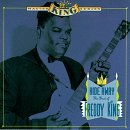
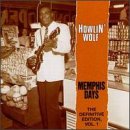

Picture from the Gibson web site



The new Gibson Les Paul Standard came out at the end of 1956 with humbucking
pickups model n° PU-490 known as Patent applied for, PAFs. Using two coils
wired in parallel and out of phase, these dual coil pickups 'bucked' the hum
players get from single coil pickups like the P90. This hum is picked up from
extraneous noise from transformers, lights and other electrical sources and
hum. Still the only finish was the Gold Top.

Picture from the Gibson web site



These new PAF pickups designed by Seth Lover to reduce the hum of the single coil P90s, came out on the Les Paul Standard from late 56. Combined with the mass of the woods Gibson used to build the Les Paul, namely a mahogany body and a thin maple cap with a big chunky neck created a wonderful palette of sounds. Listing great songs recorded on this classic guitar would cover over half of the best records, tapes, CDs and DVDs. Little did the Gibson team know this guitar would still be so desirable 50 years on. Gibson have made 2002 the fiftieth anniversary of the Les Paul.

Picture from the Gibson web site

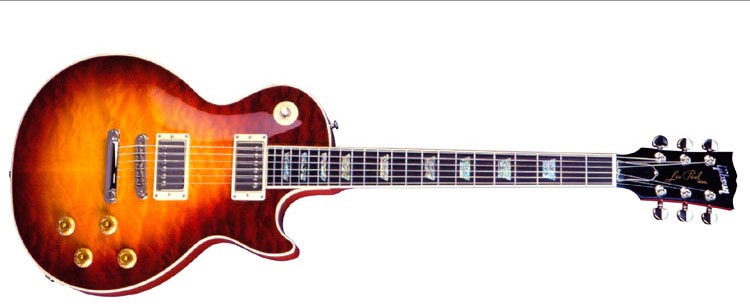

This distinctive
ballsy mid range sound coupled with an incredible capacity to sustain have made
the Les Paul Standard a true classic. The above picture is to show the beautiful work coming out of Gibson and to see a 'real' Les Paul before meeting the Ultimate. From 1965 Gibson Les Paul Standards, espescially the Sunburst late fifties and 1960 model (which had just been dropped from the Gibson catalogue) started cropping up on both sides of the Atlantic. Keith
Richards in the Rolling Stones (remember this Sunburst Les Paul with the Bigsby Vibrato?)
to the first three John Mayall albums with Eric Clapton, Peter Green and
Mick Taylor. Other UK influences included Jeff Beck, Paul Kossof, Clem Clepton,
John Mooreshead, OK I'm cheating, he had a Les Paul Custom but that's another
story, on this side of the Atlantic.
I still think the three Bluesbreakers albums pictured above with Eric Clapton reading the Beano on the cover and the next two John Mayall albums, A Hard Road with Peter Green and Crusade with Mick Taylor are the benchmarks for this kind of sound. In the USA, Billy Gibbons of ZZ Top, Michael Bloomfield, Carlos Santana, Steve Miller were coming to the same conclusion as well. So this is The Holy Grail, the Gibson Les Paul Sunburst and this is the one that is so desirable and rather expensive, up to £100,000.
Regarding the items below on your web site:
Picture from the Gary Moore's web site This is NOT the Ex Peter Green Les Paul, and image was taken from the official web site with out permission of use.
This 1960 Gibson Les Paul Standard was traded to Gary by Peter Green. The neck pickup was put back in the wrong way around by Peter and combines with his soul (and Gary's) this is a really good sounding Les Paul. It is also an example of a very worn and used Les Paul. The Ex Peter Green Les Paul is a 1959 LP Standard, not a 1960 model and the neck pickup has had the magnet turned around inside the pick up, as well as the whole pickup turned around and installed the opposite way to a standard humbucking guitar.
I have asked for permission and a picture of the correct guitar.
Gary took the
sustain to the extremes with Parisienne Walkways. I remember the stop watches
coming out on the sustained note in the song - that night Gary held it for over
two minutes playing through a triple Fender (Twin RI) Marshall 2000 Anniversary
(if memory serves me right) and a Soldano. The sound was as our American friends
would say 'awesome' and incredibly loud but very very tone tasteful.
October 2002 - Graham Gary Moore's web master writes
Regarding the items below on your web site: My response Across the seas
Mike Bloomfield, Freddy King, Muddy Waters, Howling Wolf, Duane Allman
(pictured above with a 1959/60 Les Paul Standard) & Dicky Betts of the
Allman brothers, Billy Gibbons, Carlos Santana, Steve Miller and many other
artists were using up these 'old' guitars that Gibson actually stopped
producing and making great records, and they never ceased to amaze concert
goers with their tone, taste and emotion.
Later on Pete Frampton, Al Di Meola, Robert Fripp, Steve Jones, Mark Knopfler,
Bob Marley (Gibson Les Paul Junior), Mike Oldfield, Mick Ronson, Slash, Pete
Townsend, Mick Box (Uriah Heap), Joe Walsh, Neil Young, Frank Zappa, Joe Perry,
Neil Schon, Danny Kirwan and George Harrison would end up making some memorable
tracks with the Les Paul sound central to the vibre of the song.
Sorry about the picture but I could not find a Gibson calendar.
I have to plug my favorite magazine here. Visit and get
Vintage Guitar Magasine.Cool articles, pictures and advertisements for some interesting guitars.
The Gibson Les Pauls of the 1950s and early 60s have become very sought after
and dear. Gibson and Fender were asking themselves why players were paying very
large sums of money for certain old models - like the 1959/60 Les Paul.
By 1980
Gibson started produced the Les Paul Heritage series and then went on to
produce Historic collections from 1992 to the Les Paul Standard reissues a year
later, I think this was after guitar shops like Guitar Trader in New Jersey
ordered a batch of reproduction Les Paul Standards.
In 1990 Gibson produced a
great Les Paul - The Les Paul Classic. It had a slimmer neck, too slim for some and a496R ceramic magnet humbucker in the bridge and a
500T ceramic magnet humbucker as the neck pickup
without the covers with real nice woods and finishes. I really enjoyed mine.
Now Gibson produce a varied line of Les Pauls, 20 models listed in the
Guitarist Ultimate Guitar Buyers guide 2002. From the Les Paul Junior Light to
Les Paul Smartwood Exotic. This doesn't include the Custom shop or Classic
Vintage models in the Gibson Historic collection and doesn't mention prices. Check
the Blue book for more details. Today Gibson's Les
Paul Standard has been remodelled by Gibson in 2002 into a very fine reproduction
of the late 50s / early 60s Les Paul. Henry Juskiewicz Chairman and CEO of
Gibson (since 1986) sums his product aptly "The Gibson Les Paul has set
the standard for style, sound, innovation, functionality - every element by
which an instrument is judged - for 50 years now." The most
significant change on the 2002 Les Paul Standard is with the pickups. They are
now Gibson Burst Buckers. I haven't heard these yet but more about them later. These guitars are
really very well made and accurate reproductions that are beautiful to look at
and come out very well in the Guitar Magazine reviews, but the price does make
one pause! At what price is a
guitar so expensive you would be hesitant to take it out to gigs and rehearsal
studios? That you would cry at each ding or scratch? That it becomes the price
of a car? How would you feel about dings and scratches? Every ding each of
guitars I have had is devastating but it goes with the territory and you ride
the tide. But on a $10,000 guitar I think I'd go out to the sea! But to each
his own, some players prefer to buy a pre aged (ding, scratches, rust, neck
wear etc...) new guitar rather than a new guitar. The manufacturers can charge
more so everyone is happy. I was quite interested in this model but I have yet to be enticed by a Gary Moore Les Paul Standard Signature model to even pick one up. All the five I have seen have had very unattractive finishes, funny how everything is in the eye and ear of the beholder, sickly yellow finishes and the lack of the white stripe binding, which should excentuate the look of the guitar does the opposite. So to summarise,
many of the 'sexy' vintage Les Paul Standards; like the new Les Pauls and pre
aged Historic Les Pauls, the Custom Shop Les Pauls, the Signature Les Pauls
(Jimmy Page, Joe Perry, etc...), the Semi hollow Les Pauls like the Elegant,
are very appetising and out of reach of the Stringkiller budget. Also one of the
reasons it was easy to sell my last Les Paul (Classic 1960 RI Reissue) was that it
was a little on the heavy side. After a four-hour concert you feel that you had
been holding and playing a great guitar but a heavy guitar. So this is one of
the reasons for my affection for my Tom Anderson Hollow T Telecaster and my Parker
Fly.
What a reproduction!
The link is to the photo only Ultimate Les Paul site! The
guitar model is the Tokai LS75Q Love Rocks and I think I can confirm the name is
about the worst thing about this guitar!
But what's in a name when the
reproduction is screaming out 'Gibson Les Paul Standard' to you? For those of you who might feel upset that I am calling this (foreign reproduction) guitar the ultimate. But for the price this Tokai is pretty close to delivering the real thing, but I only used the word 'Ultimate' to grab your attention ;-). So if you are a 'Gibbo' purist sorry to have hurt your feelings, but you'll get over it. I had noticed these
great Les Paul Standards in shop windows and in guitar
publications only to see they were reproduction - it amazed me that their finishes looked so good and I figured
that they would play pretty good. I found out that they have a range of models
and prices, including certain economy models in mahogany with more economic
sycamore tops. The most expensive
of the Tokai reproduction line, the LS75Q, has a real maple top on the mahogany body. I
started looking at the details, the action, the neck, the body, the neck body
join, the headstock the neck profile, the pickup installation and the overall
impression was a very faithful reproduction. The attention to detail exceeded
certain Les Pauls made by Gibson. I believe the 2002 Les Pauls Standards are
now coming out with the 'correct' top binding in the horn of the guitar. A
frequent 'error' of Gibson was having the binding cover the maple top joining
the mahogany. From what I have seen and played these new top of the line
Gibson, Gibson Custom Shop, Gibson reproductions are among the best instruments
Gibson have ever produced. Also Gibson have now come out with Gothic and Voodoo models, these models at sold at lower prices. What a great idea. I thought I better
had not pick up one of these Tokais.
You can see above how my son Alec reacted when he saw this at home. It nearly got him back to 6 string guitars! Then in a very 'rare'
trip to the guitar stores with Dinky, my wife, I started mentioning these
Tokai's looked pretty good reproductions. That the Tokai early 80 copies of the Fender 62
rosewood neck Stratocaster were considered good Stratocasters and used by guys
like Nile Rodgers of Chic when he could choose to use the original Fender. That most people who
had one of these were keeping it just the same they would keep a really good guitar. She
suggested I give it a blast when we passed by Guitar Legends in Paris. Sorry I can't link to this excellent shop as they don't have a web site.
First impressions -
the feel and the vibe is just like a Gibson Les Paul, but considerably
cheaper than the Gibson models I would want. That would something like the Gibson Les Paul
Standard figuretop reissues either the 1958 or 1959 model, whose retail price is pretty steep. My source here is
The Special Tribute Gibson Les Paul - 116 page celebration by Guitarist magazine
UK 2002. I'll come back to their conclusions later.
I also thought
these Tokais would be a great Les Paul type guitar to be able to experiment with
some of the
reissue pickups like The only downside
at that price, was that there was no case, nice guitar but not nice enough. A couple of months
after I am back in Lead Guitars, Paris and I see an outrageous quilted maple
top in a cherryburst top on a Tokai Les Paul.
She still looks OK.
But I have to effect a few changes. The Tokai is
shipped with 09/44 or 46 gauge strings. The strings were
pretty dead and too light for me so I took the opportunity to try out some
I put the DR
strings on and was blown away. Even acoustically this guitar has the volume of
a 335
and already that mid range growl that is just lurking, waiting for you to hit
the strings a little harder or
to plug it in. I did not have to change the action, and even this quite heavy
gauge is a pleasure to play. DR claim to pack
more mass into the string and it sure sounds like it. If you like Warren Haynes
or Derek Trucks, who have really opened up so well on so many different albums,
you'll hear their sound getting maxed out by the DR strings. OK Derek plays Wahburn and Gibson SGs! DR strings also claim that
these strings are easier to bend and Stingkiller agrees on this point. One week later I have to confirm that these DR strings really make this guitar sound good but they are a little heavy as and as they are so easy to bend you have to watch out you don't overdo it (too much!) and end up with a sore wrist or worse.
It was easy to set the channel nice and clean with the guitar on 6/8 and
have a nice clear sound, when you start digging in or turning up to 10 this
just calls up the sustain and a slight overdrive if you want - I am thinking
Ronnie Earl, pictured below, on the Colour of Love, if that's the one with a Les Paul on the
jacket, of Peter Green on the first Fleetwood Mac album and the Chigago and Boston albums, of the twin guitar
choruses of the Allman Brothers, Luther Allison or Jay Lacey track with the Les
Paul on his great CD.
I have never heard of any one taking the Tokai Stratocaster pickups out of
their Fender 80 copies.
I had just read
Wolf Marshall's Vintage Guitar magazine article on Buddy Guy, one of my all-time
favourite guitar players.
I have a few little
quibbles.
So I have a Les
Paul replica which is exact except for the lettering on the headstock and the
truss rod cover with a rather dishy quilted
maple top that would cost me more than 4 to 5 times if I were to get a Gibson
reproduction with as nice a top, neck, feel and sound. Someone reading
this article might get the feeling that I am slagging Gibson here - not at all
- the design and brilliance of the Les Paul is to their entire credit (with Les
of course) - they have had their good years and bad years and right now are
making the best Gibsons ever and are quite rightfully charging for their
product. I think they need to consider supply and demand - if there are pickers
out there who are buying these top end quality guitars at these prices then
everything is OK for both the producer and end user.
It is also to Gibson's credit, and once again to Les Paul himself, that the Epiphone line means that learners and players on tight budets can can an excellent instrument at a very low price. The Big, Bad and the Chubby himself is using one of their Flying Vs with P90 pickups and sounding great with it.
Tokai, as you can see in the pictures, provide a very realistic reproduction with a high quality workmanship and
with an outrageous quilted maple front at 4 to 5 times the price Gibson is
charging for their masterpieces. I guess this all comes down to value for money
or bang for the buck, as our American friends would say. I would also like
to mention the conclusions that were drawn on the Gibson Les Paul Standard
figuretop 1958 reissues. My source
here is The Special Tribute Gibson Les Paul - 116 page celebration by
Guitarist
magazine UK 2002. It is easier to compare prices between France and The United Kingdom and the rest of Europe. I think that most interested guitarists in Europe follow the US market and can use the price differentials to get the best deal. However with the recent large price rises of both Gibson and Fender on both continents, and the appetite players have for these 'old' guitars will these differences in prices decrease or increase? The Internet is also helping buyers compare similar products on different continents. I also harbor a completely unfounded suspicsion that the major US manufacturers keep the best for their home market and then for Japan and then Europe. Wow another bummer for Africa! I guess I would like to hear your opinion on this. Please note that I have tried to take all direct prices out of this web site.
They also review a
Gibson 1956 Gold Top with two P90 pickups and they give that a good write up. However
on the Gibson Les Paul Standard figuretop 1958 reissue they say: We liked - the top,
wonderful tone and overall feel of the guitar. Compared to a new
Gibson Les Paul the
Tokai is a very faithful reproduction with the right feel, action, neck, sound
and an incredible quilt maple top for a fraction of the real thing reissue.Sorry about the oxymoron!
I have heard that Tokai have agreed to stop (I don't know whether it is
manufacture or distribution) this particular model by the end of 2002 at Gibson
request. They have agreed to change the shape of the headstock and the cutaway
horn.
My conclusion if you have the money get yourself the real
thing - a Gibson Les Paul Standard, if you want to renew your affection for Les
Paul's, get one of the Tokai's cheaper and that will probably
make you want to have the real thing even more!
Amplifiers for these fine guitars would include
Contact Dr Pickup Telephone 33 1 47 08 12 12

Picture from the Keno's web site

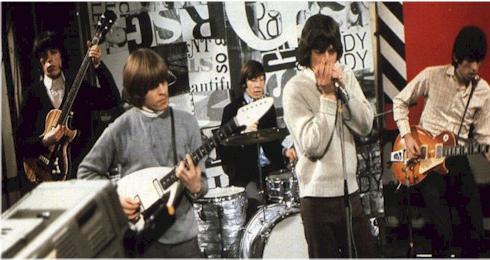


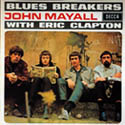
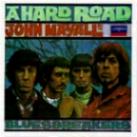
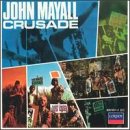

John Mayall certainly had the knack as a great bandleader of picking the best musicians and particularly "lead" guitarists.
From Eric Clapton to Peter Green's versions of the same Freddie King songs
mentioned above, Eric and Peter played on late 50s or early 60s Gibson Les Pauls Standards with PAF humbucking pickups through English valve (tube) amplifiers
like the Marshall, Hi Watt, Orange, Sound City, Vox, Laney, Watkins, Selmer
etc... 
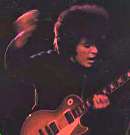

These fantastic players bought another dimension to guitar playing - inspiration, sustain,
overdrive, phrasing that took the emotion and feel of the fantastic original blues
classics and transported you to a further place in time and space. The guitar stayed
the same, the pickups, either the P90 or the humbucker coupled with the voicing
of the woods of the guitar and the smooth sustain give another dimension to
what is referred to as a ballsy rock and roll tone. The guy who replaced them in John Mayall's Bluesbreakers was Mick Taylor also on a Sunburst Gibson Les Paul Standard. Jeff Beck demonstrates his very wicked twist on things with his Les Paul Standard
on Truth and Beckola, twenty years later Gary Moore carried the torch forward
with Still got the blues for you. 
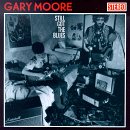

Picture from the Gary Moore's web site

This 1960 Gibson Les Paul Standard was traded to Gary by Peter Green. The neck pickup was put back in the wrong way around by Peter and combines with his soul (and Gary's) this is a really good sounding Les Paul. It is also an example of a very worn and used Les Paul.
October 2002 - Graham Gary Moore's web master writes
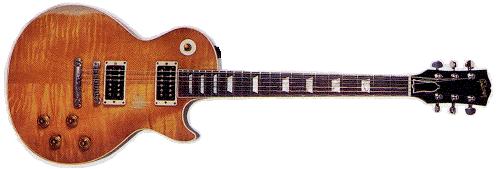

When was this? as it is not a live guitar rig Gary has used
Dear Graham,
Thank you for your speedy response and clarifications which I'll correct on the web site.
Do you have a picture of the Les Paul Gary traded with Peter Green that I can add to the web site with your permission?
The concert I'm referring to was in the early 90s at the Zenith in Paris. I was under the impression that Gary was using Fender Twin reverbs (or Dual Showman perhaps) for his clean signal and he had a Soldano head and a Marshall head on the stage. If you can correct me I will then correct my fawlty information.
Regards
Bruce
My excuses for the unintentional mistakes ;-(



![]()

No longer second
hand or used but 'Vintage' guitars.

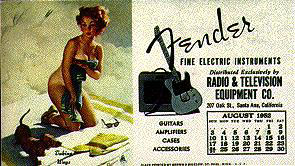

Second hand guitars
moved out of Exchange and Mart and became Vintage Guitars
and a whole trend was
started.![]()

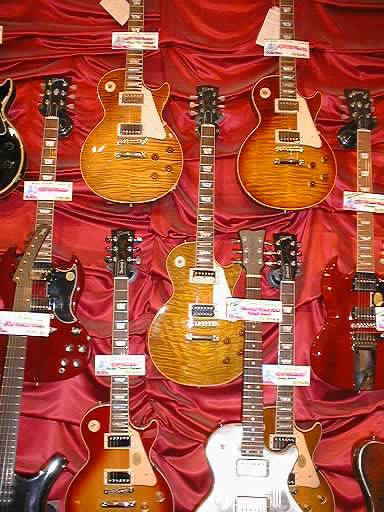

Picture taken in 2002 in Universal Guitars, Paris

![]()

This Peter Green shot is from the This un named web site

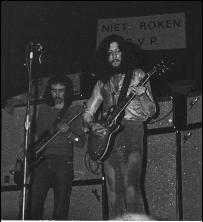

The above picture is of the brilliant Peter Green and his Les Paul Standard, which he traded to Gary Moore for a Gibson SG Special. This guitar is a very famous one and with all due respect to Gary, I can't understand why it wasn't called the Peter Green model, but I'm sure the marketing considerations got in the way.
But isn't that what makes the world go around, that we all are different and have different tastes?
![]()
See these two quilt beauties.


So Les Pauls were out for the foreseeable future. But they never are.
Just look at this Gibson Custom Shop Tom Murphy 1960 Reissue.
Wow, but I wonder how much it costs?
Along came Tokai
Tokai Europe

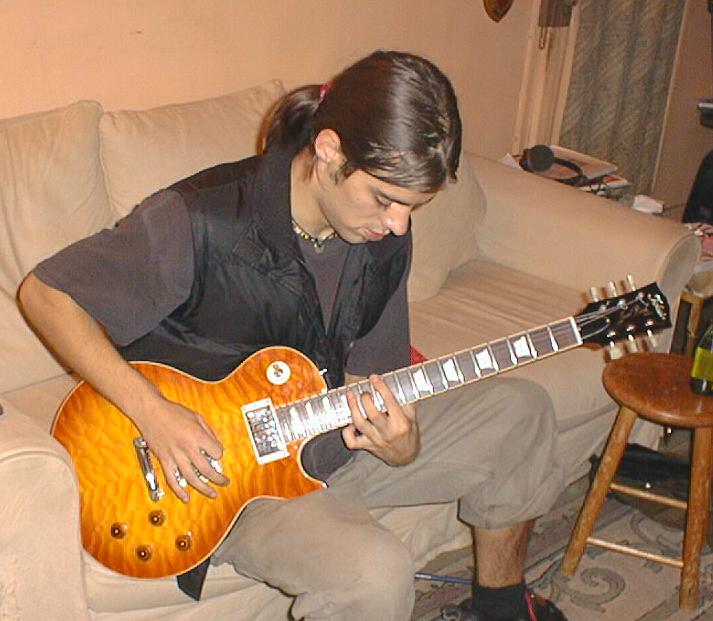

Tokai, established in 1947, is a manufacturer of Electric Guitars, Electric Basses and Acoustic Guitars
in Japan. They have a good reputation for very high quality build and
high standards for the reproduction guitars they make. I have already mentioned their early eighties Stratocasters. In 1999 or 2000 Tokai bought out a series of copies of the Gibson Les Paul which were of very high quality.
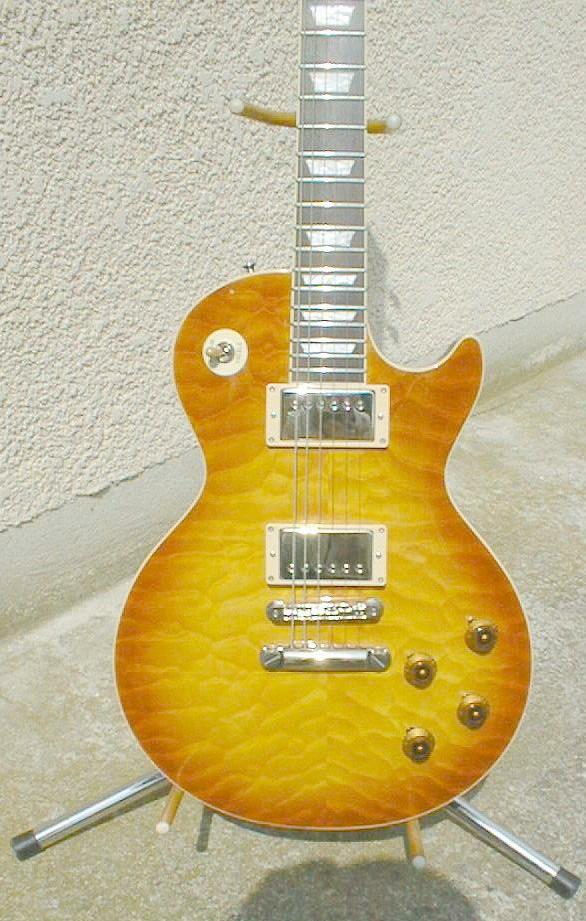
The pictures are also coming up below.


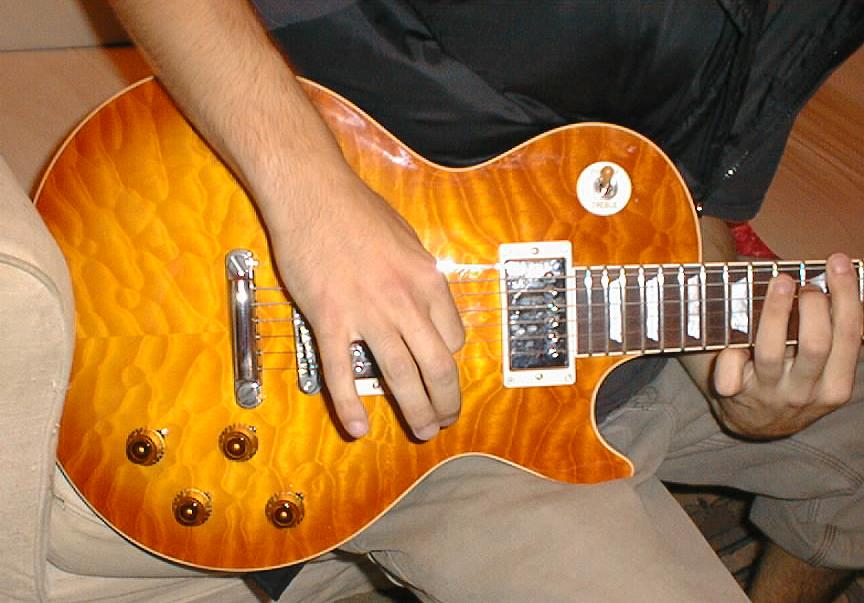

Picking the Tokai Love Rock (doesn't the name just suck?) up was interesting.
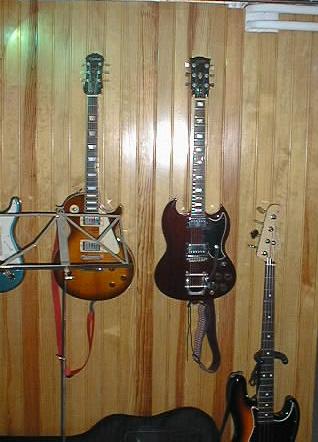

The finish on the Tokai, unlike the cheaper and very good for the price
Epiphone copies, here's one behind the music stand, stands up to close scrutiny.
I am particularly partial to Quilt Maple as you can see from my Tom Anderson
Telecaster and this top is so exceptional it is about as good as it gets.
![]()
Click for more
In these initial pictures I have not cleaned the guitar just the neck.
How do you like the finish and the top?
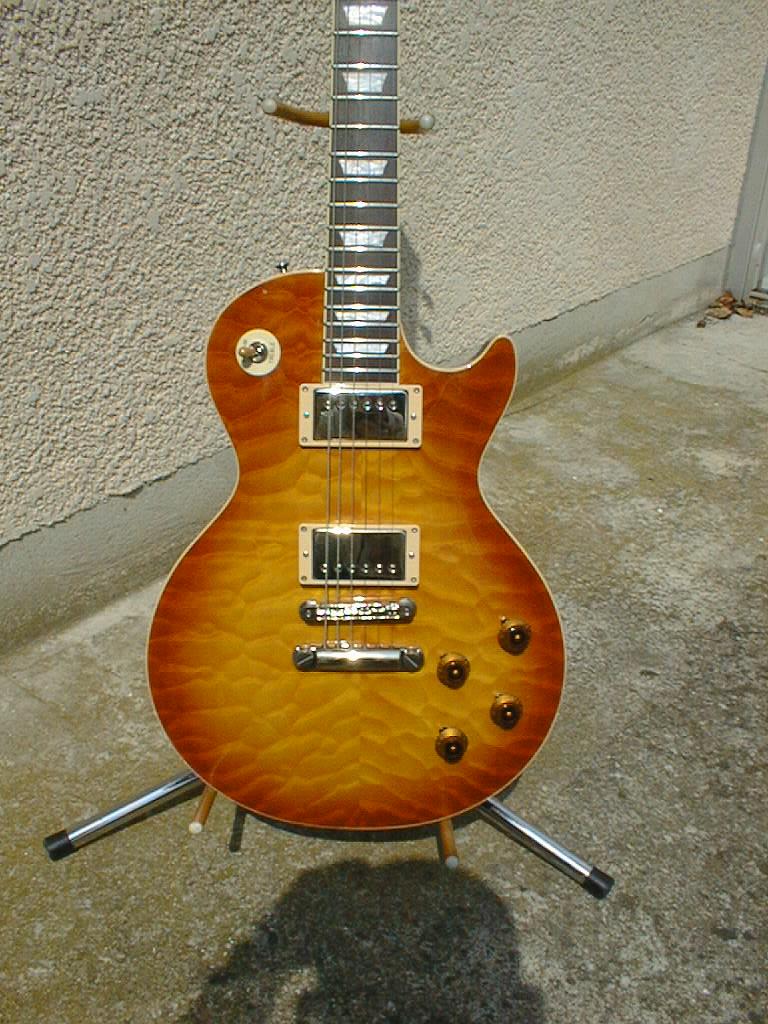

I'll do a full clean after it's first concert.
The shape of the neck is a lovely chunky 59 neck and the frets are smooth and
set up very well.
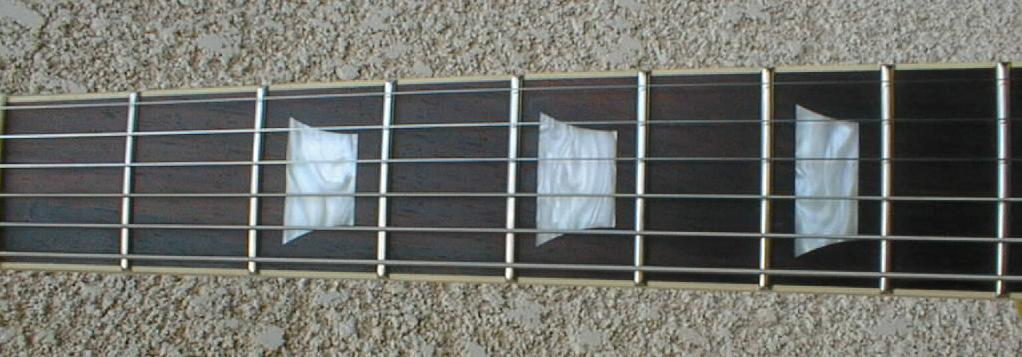


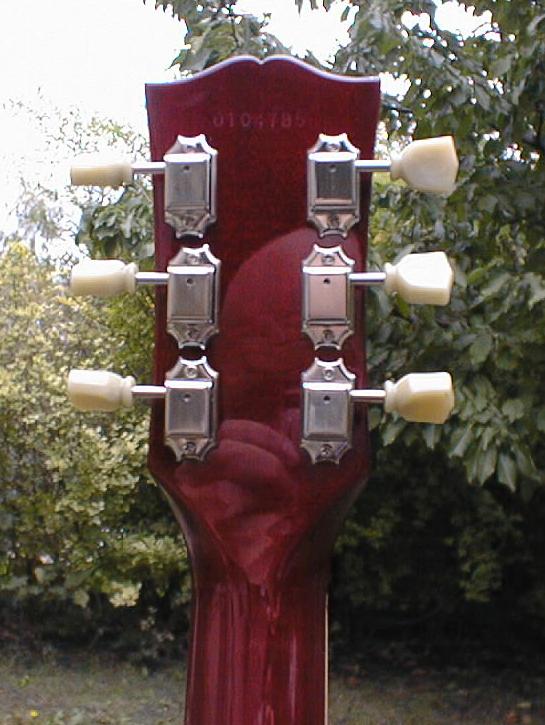

These Tulip button tuners work fine.
The volume and tone controls are smooth and the correct 'tophat' model.
Even with thin 009/46 gauge strings these Tokais had a good sound and sustain.
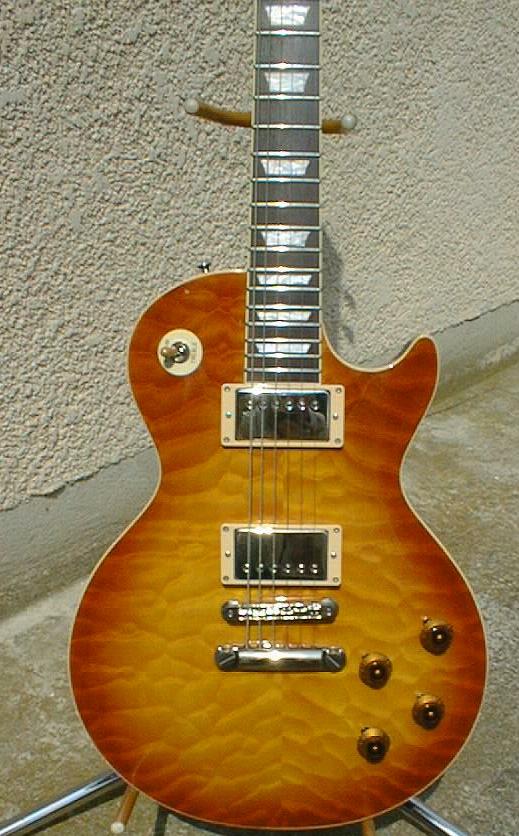

Further on down the road ..... I am in back Guitar Legends, Paris playing a nice Les
Paul Standard reproduction
with a choice of outstanding cherryburst, quilted maple, tiger stripe and wide
chevron stripes that look better
than the Gibsons costing 5 times more in the shop. At a price that makes an unattainable classic guitar that much more aquirable!.
NB The quilted maple finish
Tokai I eventually bought
was not in this shop, but they have some pretty nice ones there.
A couple of minutes through a reissue Fender Deluxe convince me that this is a
great guitar at a great price
and I better get out without doing something rash like buying one.

Here's a close up of the Tokai's lead pickup, bridge and tailpiece.
I was worried the Gotoh II humbuckers would remind me of the Heritage Guitar Company Les Paul Type model I had. The luthery was OK but I did not like the pickups. These pickups had no resemblence to the sound of the one's in the Heritage at all.

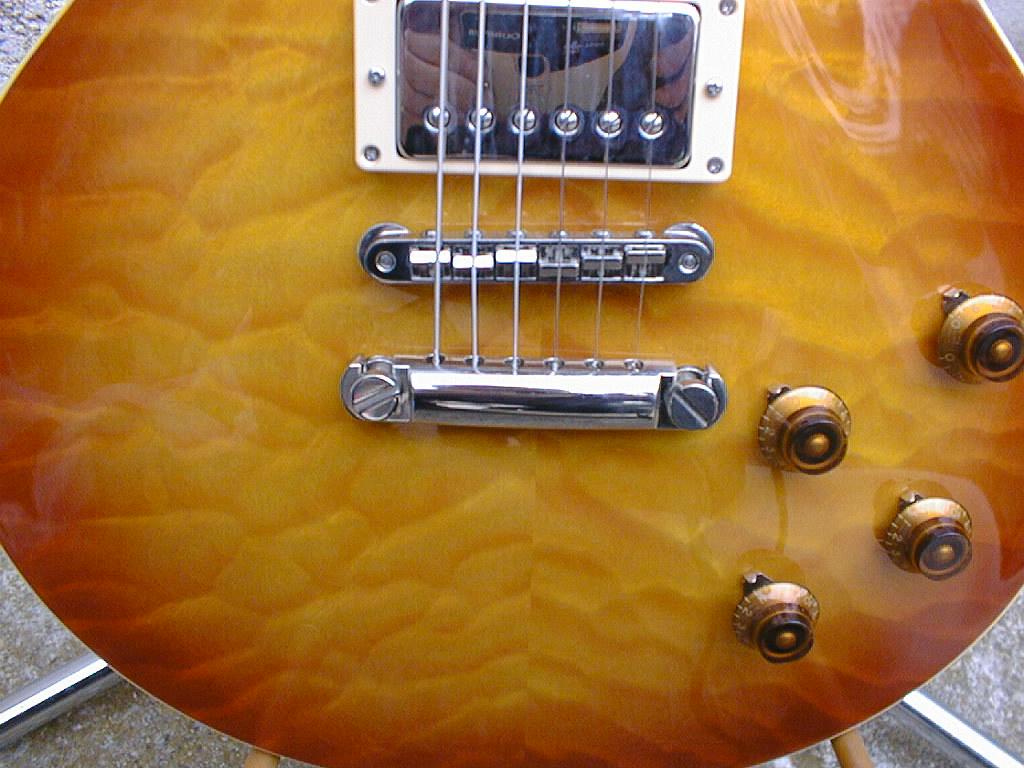

But the two models I liked weighed just like regular Gibson Les Pauls, so I
just conclude that even though
I was very pleasantly surprised by the build/materials/workmanship, the feel
and sound these Tokai reproductions were still
Les Pauls and heavy. ·
Classic
57s burstbuckers from Gibson,
·
Antiquites
from Seymour Duncan
·
Tom
Holmes Vintage guitar player shootout winners
·
and
other replacement humbucking pickups.
Picking up the guitar I realise this is the lightest Les
Paul I have picked up in a while, feels, sounds and looks pretty good.
Instant kinship, love, recognition and bonding.
That is why I call this guitar 'The Ultimate Les Paul' and it has been growing on me everytime I play it.
I buy it. My wife was not surprised! 
Stringkiller's
Tokai at home otherwise known as the morning after.



Starting with the strings.
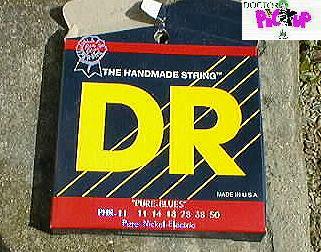

DR Pure Blues 11/56 gauge guitar strings, figuring I would have to set the action again and maybe
even give the truss
rod a tweak to keep that super low Les Paul action.

Do you drive your Ferrari on retreads?
![]()

Here are my initial
impressions of the Tokai through some different tube guitar amplifiers:·
Through
a Mesa Boogie Mark IV
·
Through
a Laney VC30 with 2 10" speakers
·
Through
a Reissue Fender Bassman 1959



Through a Mesa Boogie Mark IV -

This Tokai gave everything a Les Paul has and then some more (due to me
hahaha!). I would not use this Boogie as a reference amplifier as it can make
just about any guitar or set of pickups sound good. What I did notice on the
clean channel set at about 6, with the bright pulled out the guitar sound was
the very clear, snappy and ready to get nasty with a little digging in on the
picking. The resonance of the bass strings was nice and ballsy, clear not
mushy. I think the DR strings contribute to getting a very nice feel and balanced sound.
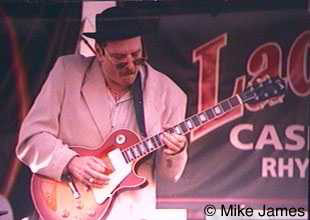

So the pickups on the Tokai are clear and don't mush the sound, they have a great balance,
and sound good. They don't sound like PAFs, they sound 'weaker' and I am not
sure that is a disadvantage. I will get back on this once I have had some shootout
comparisons with my various buddies with great Gibson Les Pauls. On the
overdrive channels the Tokai sounded fantastic but bear in mind this amplifier
brings out the best of any instrument and then some.

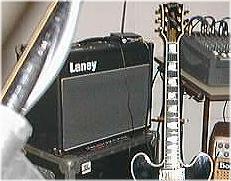

Through a Laney VC30 with 2 10" speakers -

The Tokai reacted just like a Les Paul, with maybe a little less gain but maybe
more clarity. I notice the pickups are set quite low. I like the fact they have
the pickup covers on.
On my Gibson Les Paul Classic there weren't any covers
and as the pickups were quite high (I will be experimenting with the height
over the year) once in a while the top E string would get caught under the
pickup. That was a hassle and could damage the pickup, by getting caught up in the coil and breaking one of the very thin wires wrapped around the coils.
Just the height of the pickups could explain the change in sound, but already
my idea of changing the pickups straight away is on hold, as these pickups make
the grade. So I'll keep them in for a few moths and then think about
experimenting. One of the side effects of low priced Japanese Guitars is it is
easy to put different pickups in and check them out. I would be more reluctant
to do this with a real Gibson. Just unsolder rather than cut the pickup wires.
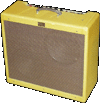

Through a Reissue Fender Bassman 1959

Again I am only on first impressions, but the Tokai sounds clearer than a real Gibson Les Paul, though this might just be due to the
rather low pickup height. Also there is isn't just one Les Paul Standard sound, you have the honk of the P90s on the early models, the smooth sustain or snarl of the Patent Applied For humbucking pickups on the Sunburst Les Pauls and then many varieties of pickups in the reissues like the Classic or the new Gibson Burst Buckers. But in all good electric guitars you are already getting a resonance and feel of that individual guitars potential and in a good Les Paul it is a pretty strong and recognisable feeling.
Bear in mind these are just first impressions but they get more and more
favourable through the Bassman. First, this is a reference amplifier for me. That means you get to hear the guitar and there's not a lot of knobs and processors getting between what is coming out of the speakers and the guitar you're playing. After all, Jim Marshall based his product on the way the Fender Bassman is built! Also it makes a good guitar sound even better.
BTW Wolf has written so many good articles on guitar music, I saw a workshop of his in South Carolina. I strongly suggest you visit this guys site and while I'm at it the Riff Interactive web sites to get your chops up. I'm working on some Hendrix and Brian Setzer stuff and it's a fun way to learn and practise.

Wolf mentions that Buddy uses a Reissue Fender Bassman 1959 and puts every
chicken head control on 12 except the Bass, which is set at zero. Try it! This
is a great setting for Fenders and also for the Tokai. As a start to really
hearing what the guitar can deliver.
Straight away you notice that the tone and volume knobs taper very smoothly,
something that was sadly lacking on many present and past Gibsons. I like the
clarity of the pickups, the sustain and the neck of this Tokai is exceptional. It is really fun playing it through an amplifier like this. I can see why Buddy Guy was always a little frustrated, if he had to turn down in the studio, only to hear Eric Clapton and Jimi Hendrix doing it on record a few years later.

Now I am using a
Kotch Twintone

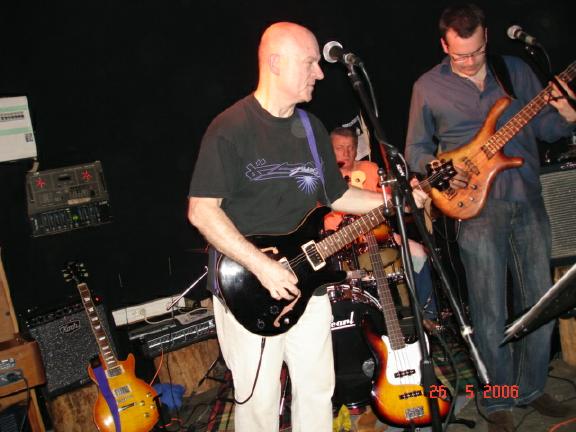

Now I am using a
Kotch Twintone

on stage
I like this amplifier for it's tone on both the clean and the overdrive channels.
The clean channel stays clean at high volumes.
The Ultimate sounds fantastic through this amp, think a pre 1965 Fender Twin at 5 plu, all that tone, the bass, middles and treble even sounding, but with or without the volume you need to have on the Twin.
By that I mean why get this amp if you can have a great sound from a Fender Twin? Because with Twintone you can have that same sound at lower volumes and it is slightly lighter and easier to carry around! Plus you have the other channel and the boost.
The Fender Deluxe, another great amp, described by some as a little Twin is OK but gets that great break sound up at higher volume settings which can be very desirable but with the Twintone you stay clean at those volumes.
The Twintone also has a neat footpedal with two switches - one is the channel selector and the other is a boost switch on whichever channel you're on.
Neat, simple and very cool for tone heaven.
So you can get your sound and set the Twintone to have it at a lower volume, and at any time call back the higher volume.

and Dr Z Mini Z

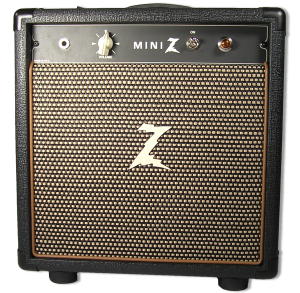

When you go to the DR Z amps site check out the soundbites under the Mini Z.
This is my favorite amp right now as it is tiny and just screams - plug it in then turn it up and control the volume and tone from guitar.
I got this from Ron at Proguitar Germany in record time.
I believe it was the last one in Europe as they have stopped making it.
After three weeks no sound came out of the amplifier, after a quick trip to Fredo of VHM, the Parisian tube amplifier surgeon, he diagnosed a dead output transformer.
He also noted the very high quality of construction and parts in the amplifier.
Within 30 minutes of emailing Ron I am informed that I am being sent a new transformer direct from the US, where Sales at DR Z confirmed it by email. Now that's service.



So I'll keep these humbuckers on for a few months and see how they perform. This
Tokai, like good Les Pauls as that fantastic midrange sound and amazing sustain
at all volumes. I have to stress that this reproduction comes very very close
to the original and with the price differentiation it makes for a fantastic
deal. Bear in mind that the woods of the body and neck and they way they are put together is a bigger contributory factor to sustain than the pickups - it's coming from the guitar.
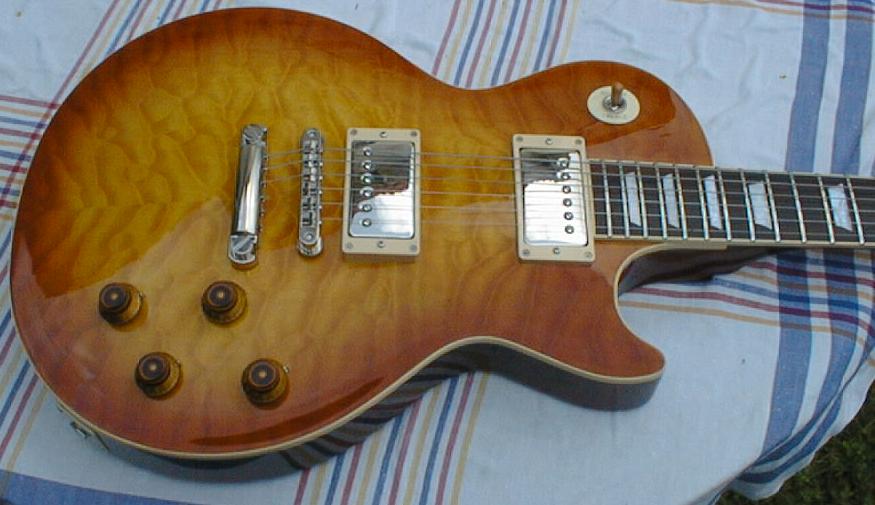

If you are in the UK go check out the price and you might very pleasantly suprised.

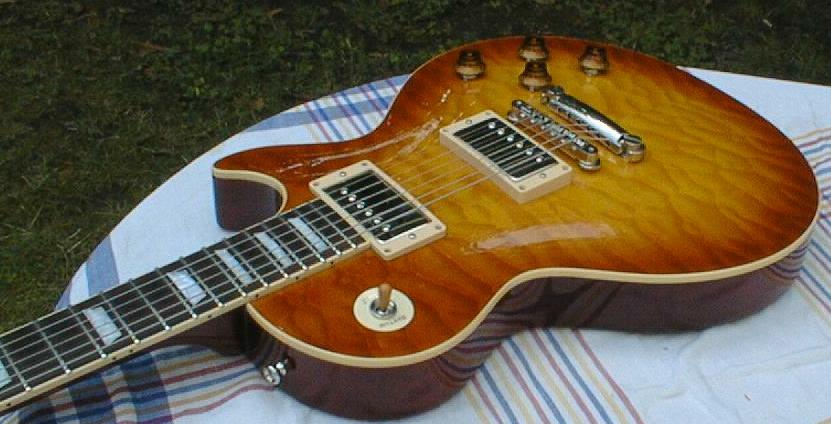

A note about the set up and action of the guitar. I already mentioned the
strings. I am amazed at the number of guitarists that have nice guitars and
crappy old strings on them! If you own a Gibson Les Paul I suggest you try the
DR Strings True blues or Pure Blues with a slightly thicker gauge than normal. 


Just remember with DR Strings to crimp the string a little before you cut it. This
is rather unseemly but a small price to pay to really let this guitar roll out
the ballsy Les Paul tone.
Where the catch? So
everything is just wonderful about this guitar?
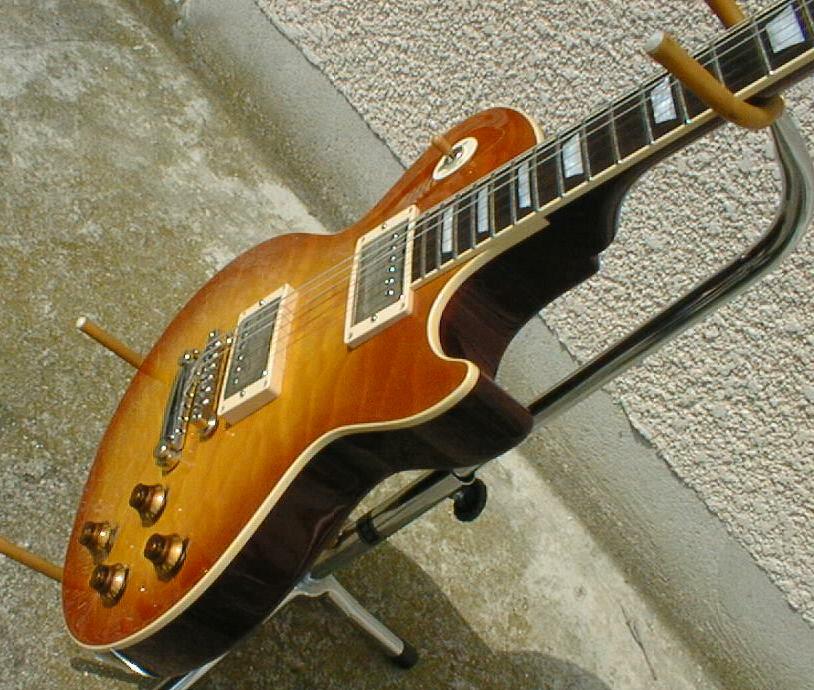

No, although it is very very good value, check the price out in your country, when put up against a real
Gibson Les Paul, it is a very good
replica but it is not the real thing. 
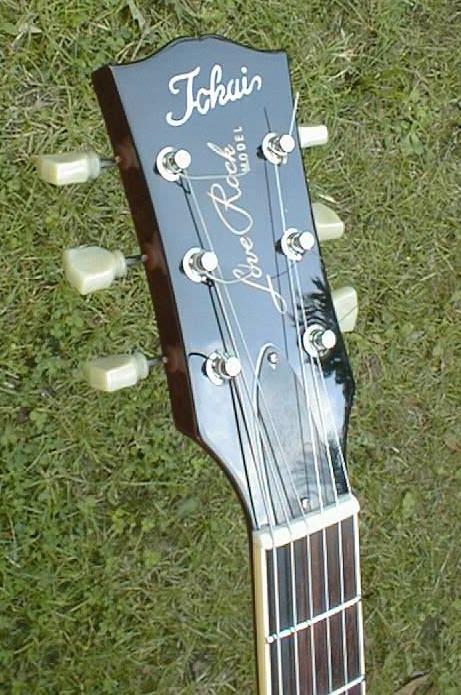

The nut is the right height and angle and set very well. There is a very slight
buzzing on the open E string, and after analysis I trace this to the nut. The
nut will be the first thing I will have to change on this particular guitar,
but is very minor. This little niggle would only be a problem in the studio. Also the action is so low with no buzzing or chking of the notes when bending that I might just raise it a little to get rid of this very minor buzz which is only on the open E string.

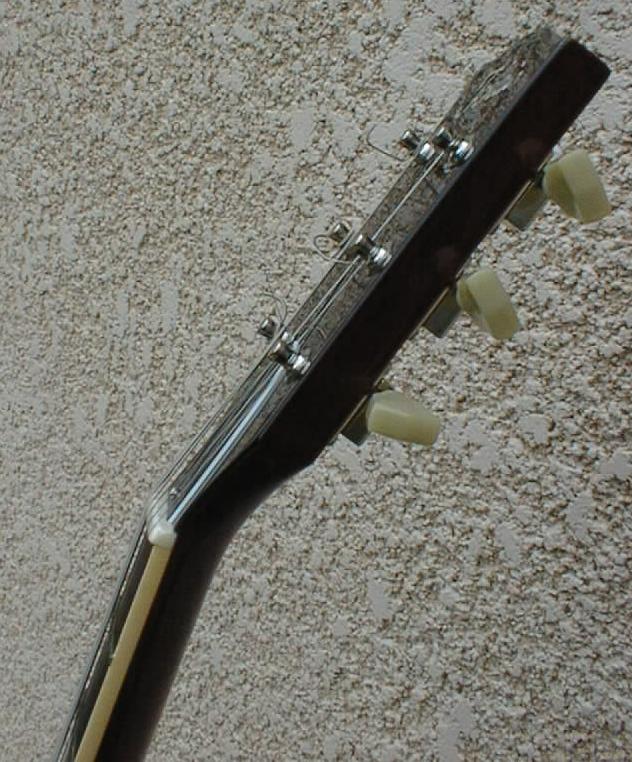

The case - It costs extra.At least you get one with Gibson!
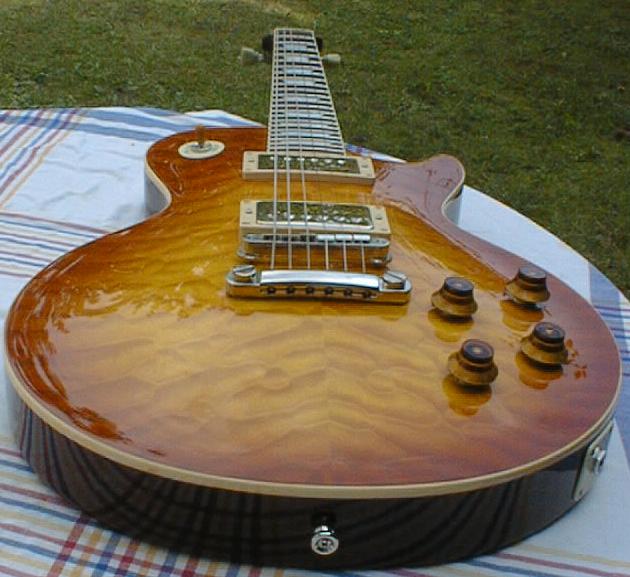

The pickups are Gotoh II humbuckers - while giving a more than honourable first impression on different
amplifiers they are not PAFs. However as I am moving away from the Gary Moore
overdrive sound toward a cleaner yet sustained sound these pickups do the job for the moment. October update - The neck pickup is perfect, note also it is very low. The bridge pickup can start squealing at extremely high volumes, easy to deal with by rolling the pickups tone down a little. The whole sound is there - those glorious Les Paul mids, the sustain, the puch and most of all a great clarity and note seperation. For the moment these pickups stay on.

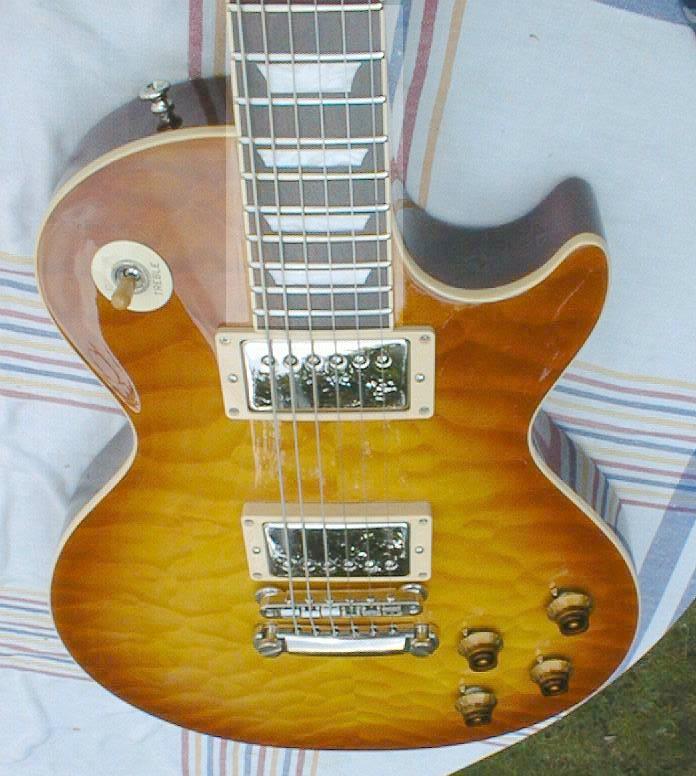

The neck inlays - If you look carefully, you see that the inlay cut out is a
little too large and filler has been used to touch up the gap between the inlay
and the neck. I tried to highlight the picture (see around the neck) but it
doesn't really show. I took some other pictures and it is the kind of detail
you see in direct sunlight. I’ll try and get some other shots. I have Tokai is
not the only manufacturer who does this. They all do. On this particular guitar
it's probably the worse manufacturing defect. I don't think it affects any
major tone change.



The accuracy of the Tokai replica complete with the sound, the feel, the vibe, the
sustain, the tones of the original at this price makes this a very attractive
package and a very honourable hats off to the original.
We disliked the neck shape, a couple of finishing defects and of course the
price.


Specifications
TOKAI LS75Q LOVE ROCK (thanks to UK Guitarist March 2001)

Origin: Japan
Body: Mahogany and Maple - the cheaper models have sycamore fronts (I think
most people can't see the difference.)
Neck: Mahogany, glued in
Nut width: Plastic, 43.5 mm - This 0.5 mm more than the specs on a new Les Paul
Standard
Fingerboard: Bound rosewood with MOP (Mother of Pearl) trapezoid markers,
406 mm 16" radius
Frets: 22 jumbo
Hardware: Tune-o-matic bridge and tailpiece
String Spacing at bridge: 51.5 mm
Electrics: Two Gotoh Vintage MkII humbuckers
Weight: (Kg/Lb) 4.39:7
Left handed: Special order only POA , Price on arrival
Options: Start up Love Rock Price not available
Japanese made LS65 Price not available(remember this is from a March 2001 Guitarist magazine)
for the LS75S or LS75Q . Sorry this isn't clear I just copied it from the magazine!
Finishes: Violin finish as reviewed in the March 2001 issue, cherry sunburst,
see through dark red, indigo blue.

Here's a close up sorry about the sunlight on this very classy quality finish.

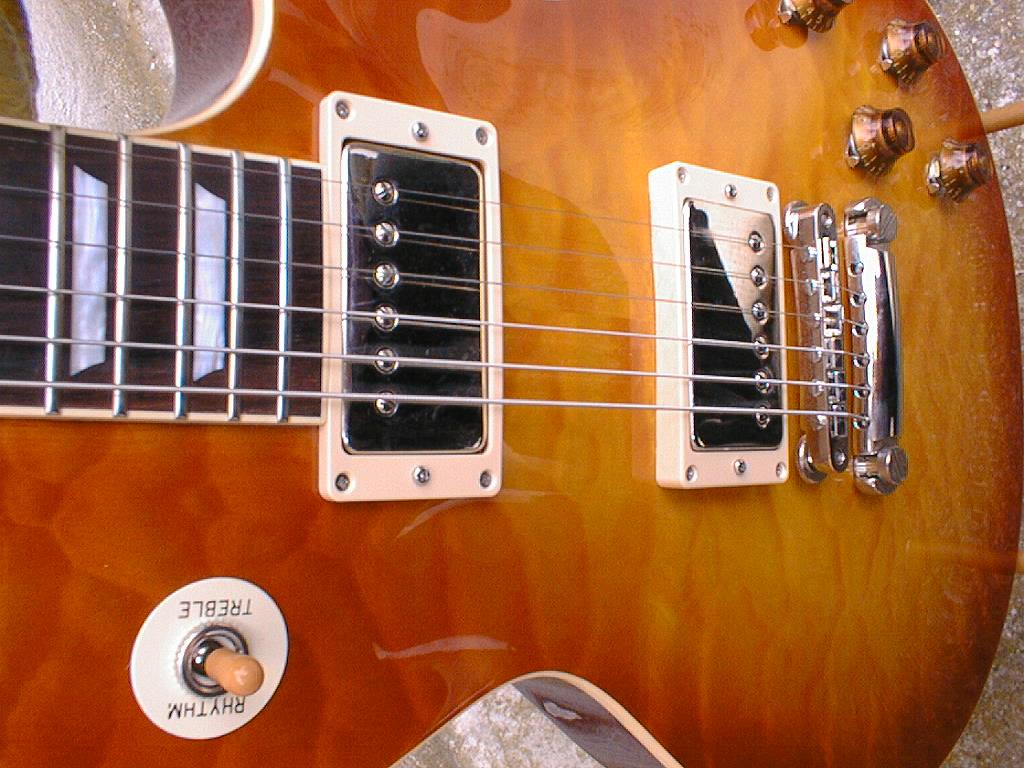

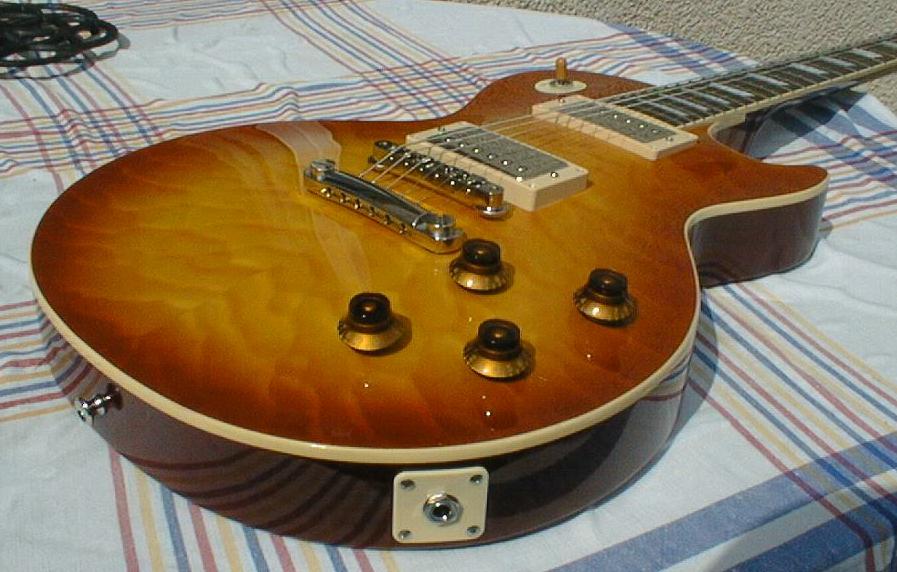

Some back shots, the flash wasn't meant to go off on the first one!

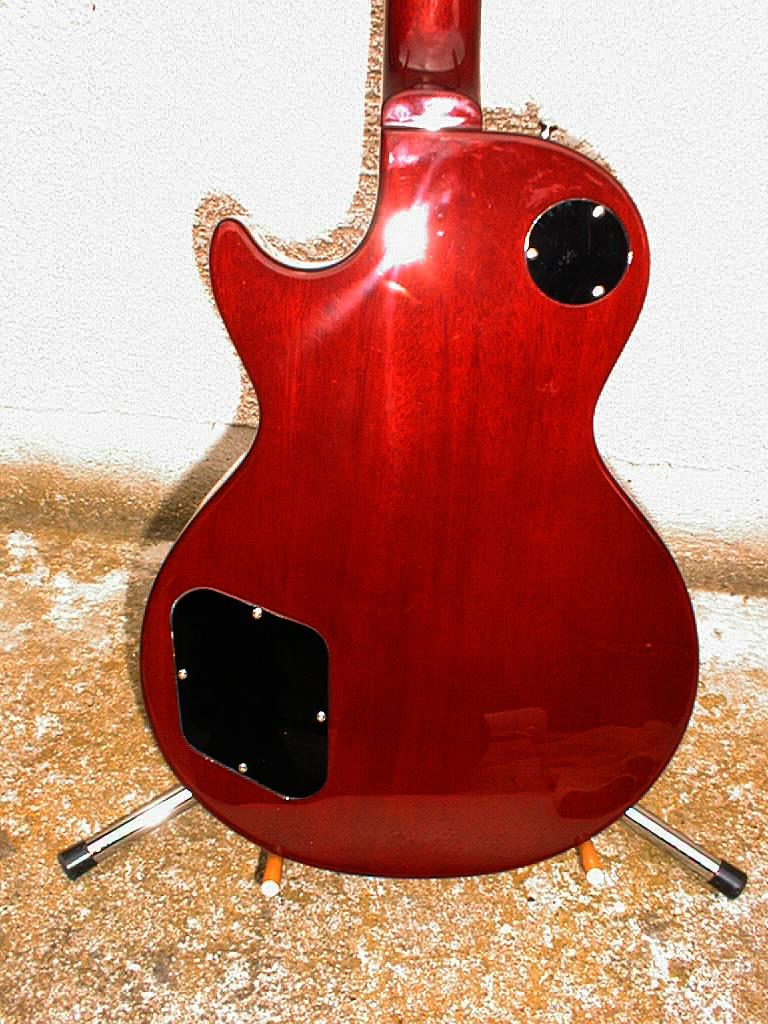
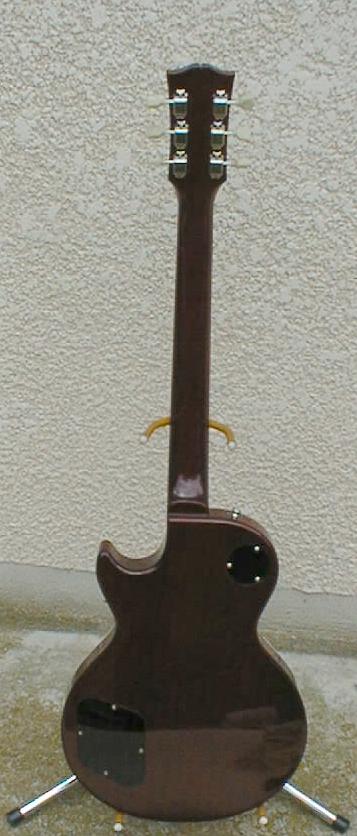



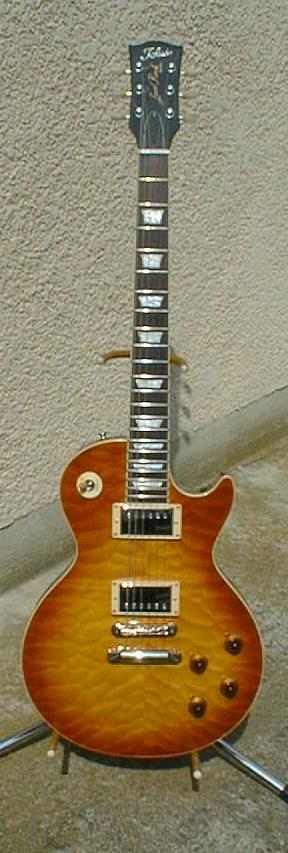

Get it while you can. This Tokai is a good deal and let's you into the magic of the real thing! I don't know what the price is of these in the USA, or even if they are sold there. I did see that the cutaway has been changed on the Tokai web site ;-(
I sugest a search on Books on the Gibson Les Paul.

![]()

The author: Bruce Stingkiller is the singer and guitarist for the Paris, France
based Dr Pickup band.
He also plays Acoustic Brit Rock with Stirling Austin in Stirling Bruce.
He also plays with Jacky Nashville's band Aventure. That link is to a concert in a chateau on 25 September 1998.
Here is the Ultimate's first rehearsal in September 2002 with Aventure.
My little Les Paul Gallery.
Here's Silent Eddie's Les Paul in action



Here's Patrick with his 1957 Historic Les Paul in action

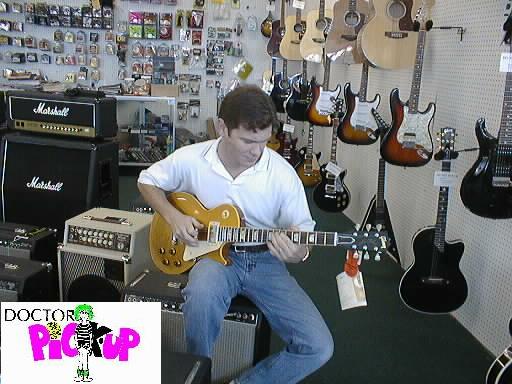

Here's the real thing with a 1952 wrap around bridge tail unit with my friend
Greg

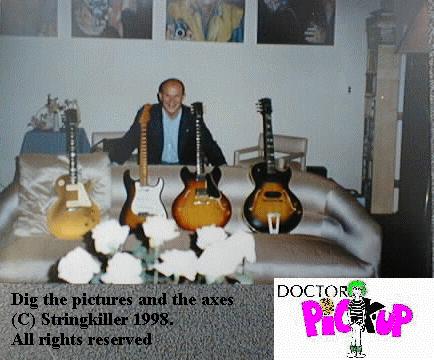


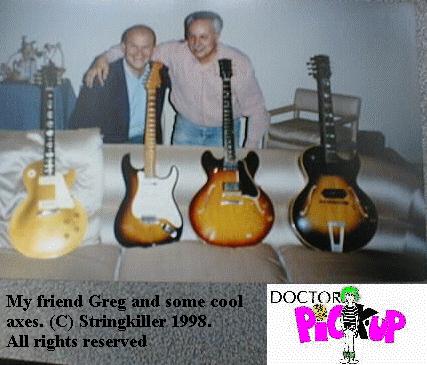

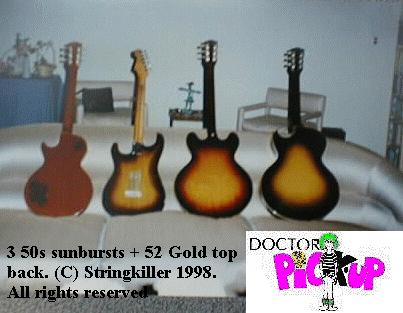

Another fantastic Tokai Les Paul Love Rock!


While I'm updating this article I may as well give you the link to my other Tokai Les Paul Love Rock - another fantastic guitar a little lighter than the Ultimate, which means she's really light.
I used this on some gigs in the States in 2005 which you can see and hear through a Mesa Boogie Blue Angel (a fantastic amplifier) in these videos.
Choose Google for the fastest connection
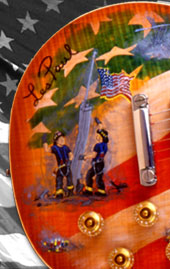
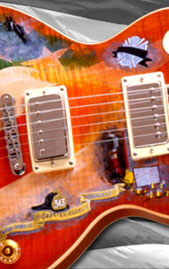
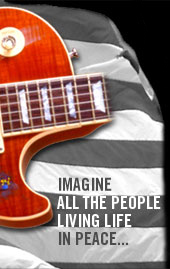



Click above to see the rest of the Imagine Les Paul from the
Gibson guitar web site.

I left some links out in the beginning, as I wanted the site to flow. I don't have the time to get the kinks for you but just use Multiple search engines like www.profusion.com and www.dogpile.com and you'll get satisfactory results in your quest for information about these wonderful guitars and the players who have performed miracles with them .
Tokai Europe
Players mentioned
Gear mentioned
Pickups
July 2006 update
Bridge pickup has become a more microphonic and needs changing.
Even with all the above mentioned remplacement pickups I staying with the Tokai Paf II model I believe, which I am waiting on from Tokai UK.
Tokai Europe
Yes this is a 'plug' for a fine instrument and great backup service.
Marshall
and so many custom shop reissues and hand wired amplifiers coming out there are too many to list here.
I have added in a few like Carr and Cornford that I'm looking forward to trying out next time in the US or UK.



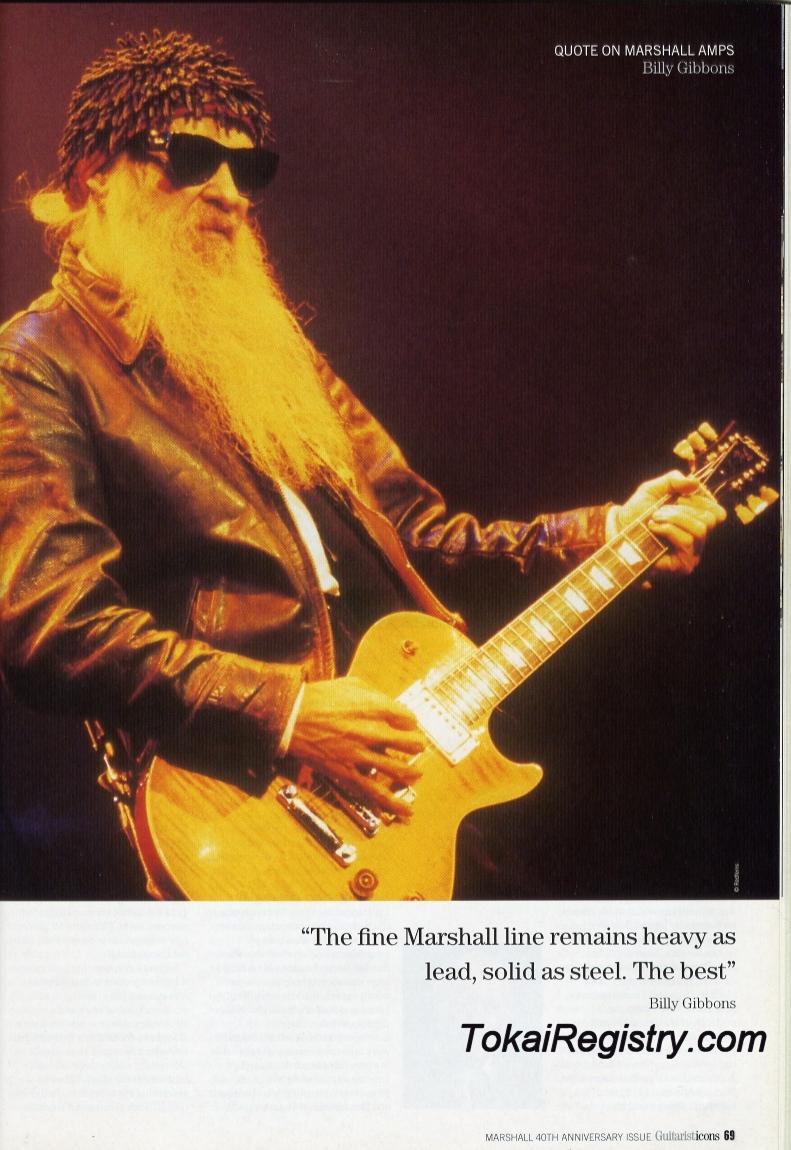
This picture says it all

 The Dr Pickup video/
Concert files/
People /
Musical instruments /
The Dr Pickup video/
Concert files/
People /
Musical instruments /
Up coming Concert dates/
Home


